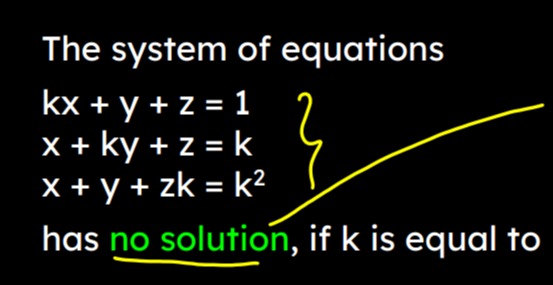Question
Question: The system of equations $kx + y + z = 1$ $x + ky + z = k$ $x + y + zk = k^2$ has **no solution**, ...
The system of equations
kx+y+z=1 x+ky+z=k x+y+zk=k2
has no solution, if k is equal to

1
-2
2
-1
-2
Solution
The given system of linear equations can be represented in matrix form AX=B, where: A=k111k111k, X=xyz, B=1kk2.
A system of linear equations AX=B has no solution if det(A)=0 and the rank of the augmented matrix [A∣B] is greater than the rank of the coefficient matrix A.
First, we calculate the determinant of the coefficient matrix A: det(A)=k(k2−1)−1(k−1)+1(1−k) det(A)=k(k−1)(k+1)−(k−1)−(k−1) det(A)=(k−1)[k(k+1)−1−1] det(A)=(k−1)[k2+k−2] det(A)=(k−1)(k+2)(k−1) det(A)=(k−1)2(k+2)
For the system to have no solution or infinitely many solutions, det(A) must be zero. det(A)=0⟹(k−1)2(k+2)=0 This gives k=1 or k=−2.
Case 1: k=1 If k=1, the system becomes: x+y+z=1 x+y+z=1 x+y+z=1 This system has infinitely many solutions.
Case 2: k=−2 If k=−2, the system becomes: −2x+y+z=1 x−2y+z=−2 x+y−2z=4
The augmented matrix is: [A∣B]=−2111−2111−2∣∣∣1−24
Performing row operations: 100−2−3313−3∣∣∣−2−36 (after swapping R1,R2 and applying R2→R2+2R1, R3→R3−R1) 100−2101−10∣∣∣−213 (after R2→R2/(−3) and R3→R3−3R2)
The rank of A is 2, and the rank of [A∣B] is 3. Since rank(A)=rank([A∣B]), the system has no solution for k=−2.
